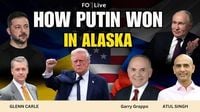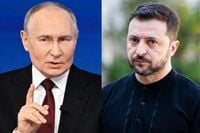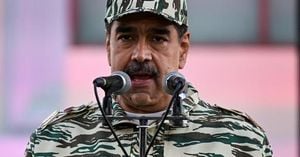In a whirlwind week of international diplomacy, U.S. President Donald Trump has thrust himself into the heart of Europe’s security debate, making bold claims, enacting controversial policies, and igniting fierce debate on both sides of the Atlantic. On Monday, August 25, 2025, Trump told reporters from the Oval Office that European leaders “jokingly” refer to him as the “President of Europe.” With a characteristic flourish, he declared, “They jokingly call me the president of Europe. Which is an honour. I like Europe. And I like those people. They’re good people. They’re great leaders.” According to reporting from multiple outlets, this remark followed a high-stakes week that saw Trump at the center of two major summits—one with Russian President Vladimir Putin in Anchorage, Alaska, and another with seven European leaders and Ukrainian President Volodymyr Zelenskyy in Washington.
Trump’s “President of Europe” claim was more than just a throwaway line. It came after a rare gathering that brought together European Commission President Ursula von der Leyen, France’s Emmanuel Macron, Germany’s Friedrich Merz, Italy’s Giorgia Meloni, Finland’s Alexander Stubb, the UK’s Keir Starmer, and NATO Secretary General Marke Rutte, alongside Zelenskyy. Trump boasted that the meeting represented “38 European and other countries,” underscoring its significance and the diplomatic pressure being exerted on the U.S. president to maintain American support for Ukraine in its ongoing war with Russia. The European Commission, for its part, declined to comment on Trump’s self-styled new title, leaving the quip to hang in the air as a symbol of the current uncertainty in transatlantic relations.
The Washington summit, as reported by Fair Observer, was not just a photo opportunity. It was a critical moment for Ukraine and its European allies. The main agenda: persuading Trump not to waver in his support for Kyiv. The stakes were heightened by the context—just days before, Trump had met privately with Vladimir Putin in Alaska, their first face-to-face encounter since 2019. That meeting, according to retired CIA officer Glenn Carle and former U.S. Ambassador Gary Grappo, was a symbolic and practical victory for Putin. Carle described Trump’s relationship with Russia as “bizarre,” claiming that the U.S. president often echoes Russian foreign policy talking points verbatim. The Anchorage summit, he argued, broke the containment imposed on Russia since the Ukraine invasion, granting Putin renewed international legitimacy. “Trump achieves his personal goal—being the center of attention and restoring Putin’s prominence—while Europe is sidelined and Ukraine left in a vulnerable position,” Carle said during a live analysis.
Grappo went further, calling Trump’s treatment of Putin “bizarre, uncanny and solicitous,” and highlighting the Russian leader’s deliberate power plays, such as keeping Trump waiting—a classic diplomatic tactic to signal dominance. Putin, Grappo noted, even flattered Trump with dubious claims, including that Trump had won the 2020 U.S. election and that Russia would not have invaded Ukraine if Trump had remained in office. Both Carle and Grappo agreed that the Anchorage meeting yielded little for Washington, but much for Moscow, with Trump appearing to move toward Putin’s preferred “swift peace plan” for Ukraine. Genuine peace agreements, Grappo warned, are complex and time-consuming, and Trump’s negotiating team lacks the expertise to manage such intricacies.
The Washington summit was widely seen as an attempt at damage control. European leaders, aware of the fallout from Anchorage, sought to shore up U.S. commitment to Ukraine. Zelenskyy’s presence was particularly significant, coming after a bruising episode in February when U.S. Vice President JD Vance publicly told him to capitulate, straining already-tense U.S.–Ukraine relations. The presence of European leaders in Washington, according to Grappo, helped prevent a repeat of that debacle. Yet, Trump’s talk of territorial concessions unsettled both Zelenskyy and his European allies, raising fears that the U.S. might pivot toward Russian terms. Some U.S. officials floated the idea of peacekeeping missions, but Grappo cautioned that such assurances could evaporate quickly if not directly endorsed by Trump himself.
As the diplomatic drama unfolded, Trump also signed a controversial executive order criminalizing the burning of the U.S. flag—a move that directly challenges the Supreme Court’s 1989 ruling protecting flag burning as free speech under the First Amendment. “Anyone found guilty could face one year in prison, with no early release,” Trump declared, adding that foreign nationals convicted under the order could lose visas, be denied green cards or citizenship, and even face deportation. The executive order allows prosecution if flag burning incites violence or public disorder, raising fresh questions about the balance between national symbols and constitutional rights.
Meanwhile, Trump’s interactions with Putin continued to raise eyebrows. On Monday, he told reporters, “He doesn’t like him,” referring to Putin’s feelings about Zelenskyy. “I have people I don’t like, I don’t like to meet with them.” Trump’s candor underscored the deep personal animosities shaping the high-level diplomacy at play—and the difficulties of forging any meaningful agreement while such tensions persist.
Reactions to Zelenskyy’s leadership and the state of European politics were mixed. Some European journalists criticized Zelenskyy’s all-black attire and brash posture at the summit, but Carle dismissed these concerns, praising Zelenskyy as a wartime leader. European leaders, apart from Italy’s Giorgia Meloni, were described as facing domestic fragility due to economic hardship and low approval ratings. Despite these challenges, both Carle and Grappo agreed that European unity on defending Ukraine remains strong. Polls show that while many Ukrainians desire peace, large majorities oppose territorial concessions—an important nuance, as Grappo pointed out, that is often lost in simplistic polling questions.
The broader context, as Carle noted, is one of repeated Western failure to confront Russian aggression, from Georgia to Crimea to Ukraine. Trump, he argued, represents a continuation of this pattern, offering little interest in complex policy and an approach driven more by self-image than coherent strategy. Grappo was only “microscopically” more optimistic after the Washington summit than after Anchorage, hoping that European and Ukrainian leaders could persuade Trump of the importance of Ukraine’s security. The kidnapping of thousands of Ukrainian children by Russia, Grappo emphasized, is a brutal policy with long-term consequences—one that demands a principled response from the West.
Looking ahead, the future of Ukraine and NATO hangs in the balance. Grappo believes Trump is still fixated on staging a trilateral summit with Putin and Zelenskyy, though he doubts Putin’s willingness to participate without major U.S. financial commitments. Carle sees a possible workaround: the U.S. could provide arms to NATO countries, which could then transfer them to Ukraine, allowing Trump to maintain his pro-Putin image without entirely abandoning Kyiv. Ultimately, the experts agree, Ukraine’s fate and the future of NATO depend on continued American and European support—and on the unpredictable calculus of a president who, for now, claims to be “the president of Europe.”
The week’s events have left allies and observers alike grappling with new uncertainties. As Europe weighs its reliance on an unpredictable U.S., and Ukraine fights for its survival, the stakes for transatlantic security have rarely felt higher.





